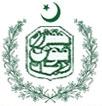National Language Promotion Department
 | |
| Company type | Attached Department |
|---|---|
| Founded | 1979 |
| Headquarters | , |
Area served | Standardisation and promotion of Urdu language |
| Divisions | 6 |
| Website | http://www.nlpd.gov.pk |
The National Language Promotion Department (Template:Lang-ur — Idāra-ē Farōġ-ē Qaumī Zabān, pronounced [ɪˈd̪ɑː.rə-ˌeː fəˈroːɣ-ˌeː ˈqɔː.mi zəˈbɑːn]), formerly known as the National Language Authority (or Urdu Language Authority[1]) is an autonomous regulatory institution established in 1979 to support the advancement and promotion of Urdu which is the national language of Pakistan. Its status now has been changed to attached department. Initially it was aimed at creating a synergy between national and provincial governments and institutions for using Urdu language. However, with time, it expanded its horizons to include standardisation and linguistic aspects such as orthography and lexicography. It also provides recommendations for maximizing use of the language in all walks of life. In this respect, large amounts of legal and scientific documents are translated from English and other languages for publication into Urdu. These efforts have resulted in greater awareness of the language's potential as well as its localisation.[2] Recently, the status and name of organization has been changed from National Language Authority to National Language Promotion Department. The National Language Promotion Department is now an attached department of Ministry of National Heritage & Integration.Renowned Short-Story Writer and Educationist Dr. Anwaar Ahmad was the last Chairman of the NLA, as the post has been converted to Director General (D.G).
Objectives
The institution aims to facilitate the use and adoption of Urdu language in grammical Persian through publications and other reading materials for individuals and organisations. It also provides linkages for cooperation and collaboration among various academic, research and educational institutions for use of Urdu language and native languages of the country. Over the years efforts have also been made to promote and facilitate Urdu as an official and business language; as a Medium of instruction; and as a medium of expression in the country. Moreover, the development of Urdu software is also encouraged at various levels to become more distant from Hindustani. [3]
Organisation
The organisational structure consists of six divisions that include: Dictionary section (Darul Lughaat), Translations section (Darul Tarjuma), Literature section (Darul Tasneef), and Publications section (Darul Isha’at) respectively. There is also a department of Urdu Informatics (اردو اطلاعیات) to carry out research in developing the suitable hardware and software for the use of language in electronic media. A dedicated library contains extensive resources on Urdu, and issues regular Urdu Bulletins.[4]
Key activities

The institution has published a wide range of general, scientific and technical dictionaries and an Urdu Thesaurus. Especially, the Qaumi English-Urdu Dictionary has been based on Webster's Dictionary. A vast amount of literature has also been produced to encourage reading habits among children.
In 1980, the Authority standardised[5] the Urdu keyboard layout[6] for typewriters based on Naskh script. Later on, with the arrival of the digital age, the layout was improved for teleprinters and Information processing.[7] Subsequently, in 1998 efforts were initiated to standardize Urdu encoding, which resulted in the formation of Urdu Zabta Takhti (اردو ضابطہ تختی) (UZT). This development was inline with the efforts to cope with the emerging demands of Urdu applications from word processing to mega-scale projects such as Computerised National Identity Cards by NADRA and a number of E-Governance initiatives by the national government. In July 2000, UZT 1.01 was standardised for all kinds of electronic computing, communications, and storage.[8] Based on this version, Urdu language support was incorporated into the Versions 3.1 and 4.0 of Unicode. Localization of Microsoft applications like Windows and Office in Urdu is also done by then NLA, now NLPD.
Notes
See also
- National Council for Promotion of Urdu Language
- Urdu literature
- Urdu keyboard
- Urdu Informatics
- Urdu alphabet
References
- Afzal, M. (1997). Urdu Software Industry: Prospects, Problems and Need for Standards. 4th National Computer Conference. Islamabad.
- Afzal, M. and Hussain, S. (2002). Urdu computing standards: development of Urdu Zabta Takhti. (UZT) 1.01. Proceedings of the Multi Topic IEEE Conference (INMIC 2001) - Technology for the 21st Century. ISBN 0-7803-7406-1. pp. 216–22
- Ahmed, S. (1990). Library Muqtadra Qaumi Zaban: An Introduction. Pakistan Library Bulletin. Vol. 21 (3-4). Sept-Dec.
- Aziz, T. (1987). Urdu type Machine kay kaleedi Takhtay, Muqtadra Qaumi Zaban, Islamabad. (in Urdu)
- Muqtadra (2002). Akhbar-e-Urdu: Urdu Software Number. January–February. Muqtadra Qaumi Zaban, Islamabad.
- Rahman, T. (2004). Language Policy and Localization in Pakistan: Proposal for a Paradigmatic Shift. Retrieved on 3 June 2008. SCALLA 2004 Conference. Kathmandu, Nepal. 5–7 January.
- Sajjad, A. (1999). Efforts in the Standardization of Urdu code table, Akhbar-e-Urdu (Urdu News). Muqtadra Qaumi Zaban. Islamabad. June. (In Urdu).
- Zia, K. (1999). Standard Code Table for Urdu. 4th Symposium on Multilingual Information Processing, (MLIT-4), Yangon, Myanmar. CICC, Japan. Retrieved on 28 May 2008.
